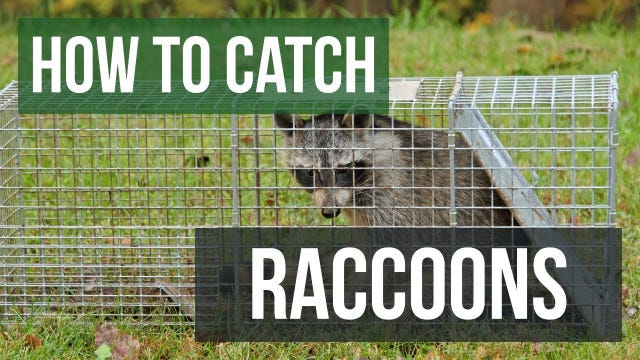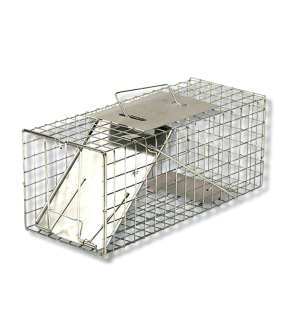Gain access to personalized product screening, the best pricing, rewards, and more!
Most Effective Products
How to Catch a Raccoon with a Live Trap
While they may look cute, raccoons can be difficult to deal with. These animals may destroy your property and push over heavy items such as trash cans in search of food. Raccoons are intelligent but can be aggressive. One method of removing a raccoon from your property is using a live trap to catch and release the animal. Live trapping is a safe and effective way to keep animals away from your home.
If you want to catch a raccoon with a live trap, read this guide for instructions and product recommendations.
Identification
Before using a live trap, you must ensure that the wild animal you are dealing with is a raccoon. This will ensure that you are using the correct bait and strategies.

Raccoons are generally 12 inches tall and 24 to 38 inches long. They have gray fur and a striped tail. The black marking on their faces resembles a mask. They normally weigh between 15 and 25 pounds and are intelligent animals. At times, raccoons can adapt to be "cage-wise." This means that once they understand that they will be stuck in the live trap, they will avoid all traps, making your live trap ineffective.
Raccoons are nocturnal and particularly aggressive wild animals. Take caution when approaching or handling this animal. They are great climbers and can swim.
Use the image and description above to confirm that you are dealing with a raccoon on your property.
Inspection
Once you have confirmed that your pest animal is a raccoon, it is helpful to recognize the areas where it is most active. This is where you will place your live trap.
Where to Inspect
You want to pick areas with high raccoon activity. These animals are most likely searching your property for food. Areas where trash and vegetation are stored are likely to be spots where raccoons are most active. If your property is near a wooded area or a body of water, raccoons might also be near these areas.
What to Look For
Because raccoons are nocturnal animals, any damage will be done at night. Certain signs signal raccoon activity, such as trash cans that are pushed over, damaged gardens, and raccoon tracks. These tracks will look like tiny hands about 2 to 3 inches wide. If raccoons are trying to enter your attic, you might see damaged roof shingles.
Treatment
Now that you have identified your pest animal as a raccoon and noted areas where it is most active, you can use your live trap. Wear gloves when handling the trap to prevent leaving your scent. If a raccoon picks up a human scent on the trap, it will avoid the trap, making it ineffective.
Step 1: Remove Food Sources
You want the raccoon to enter the live trap with the help of bait. Because of this, competing food sources need to be removed. Keep your trash sealed in trash bags and stored in trash bins with a lid to keep it closed. Any pet food or water bowls should be placed inside as soon as possible.
Step 2: Place the Trap
By now, you should have noted areas with high raccoon activity. These are where you will put your trap. Be sure to place your trap on an even surface. A raccoon might push or knock over the trap to reach the bait inside. To avoid this, place a brick or weight on top of the trap.
Step 3: Bait and Set the Trap

Using the proper bait will increase your chances of catching a raccoon. These animals prefer sweet foods such as marshmallows. The bait should be placed near the back of the trap. This ensures the raccoon must step on the trigger plate to reach the food.
You will then set your trap by pushing on the door lock and lifting the door plate. Keep the door plate lifted while pulling the trigger arm forward to set it. You will know it is set when the trigger arm's hook catches the door.
Step 4: Monitor the Trap

You will need to check the traps twice a day, preferably once in the morning and once in the evening. This is when you will refill bait if needed. Checking the trap frequently may dissuade raccoons from approaching the trap. Do not keep an animal trapped in the cage for 24 hours.
Step 5 - Relocate the Raccoon
Any non-target animals should be released immediately. Once you have captured a raccoon in your live trap, check with your local authorities to ensure you correctly relocate the animal. Approach the trap slowly and use a gentle voice. Place a towel over the cage to avoid frightening the raccoon. Once you have relocated far enough, carefully open the trap and release the animal. You can read more about releasing an animal from a live trap here.
Prevention
After using your live trap, you want to ensure that wild animals do not invade your property again. You can take some preventative measures to keep your area raccoon-free.
Sanitation
Keeping trash out in the open is an invitation for a raccoon. Be sure to place all waste in a trash can, preferably with a lid to keep it closed. Remove all clutter and debris from your property since raccoons may be drawn to nest and burrow in these areas. Any potential food or water sources, especially pet food, should be properly sealed in a container and stored indoors. Regularly check the property for spots that retain water.
Exclusion
If your property is near a wooded area and you have no fencing, you are more susceptible to having raccoons and other wild animals invade your property. Consider blocking off your property with some fencing.
To prevent raccoons from entering your home, check the foundation for cracks and crevices. These can be sealed with Stuf-Fit Copper Mesh and caulk. Stuf-Fit is a breathable material that many animals cannot chew through. It will not rust and can be stuffed into cracks and crevices before sealing with caulk. Repair any voids or openings around the home or structure, such as damaged screens around windows and dilapidated fences.
Key Takeaways
- Raccoons are nocturnal animals with gray fur, striped tails, and black markings on their faces that resemble masks. They are intelligent and curious but can be aggressive when searching for food or when provoked.
- Bait the live trap with sweet food like marshmallows, making sure it is placed behind the trigger plate of the trap.
- Check the trap once in the morning and once in the evening. Once a raccoon is caught, check with your local authorities to ensure you safely and correctly release it.
- Remove potential food sources and trash and seal cracks and crevices with Stuf-Fit Copper Mesh and caulk to prevent raccoons from entering your property again.








